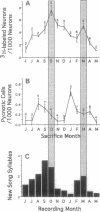Abstract
Adult male canaries modify their song every year. Most of these changes occur during late summer and early fall, after the end of the breeding season, and in late winter, immediately before the onset of the next breeding season. The high vocal center (HVC) is an important nucleus in the brain pathway that controls this learned behavior. New neurons continue to be added to the HVC of adult male canaries, where they replace older neurons that have died. The present report describes the monthly incidence of cell death and neuronal addition in the HVC of such birds. Different groups of 1- to 2-year-old male canaries were treated with [3H]thymidine, a marker of cell birth, during each month of the year and killed 27 days later. The ratio of 3H-labeled neurons to all neurons in the HVC showed seasonal peaks and troughs. This ratio was highest in October and March. Peaks in the ratio of pycnotic (dying) HVC cells to all neurons in HVC preceded the peaks in the ratio of 3H-labeled neurons. We suggest that seasonal peaks in cell loss and neuronal recruitment in HVC are related to endocrine changes and that all three play a role in the seasonality of song modification.
Full text
PDF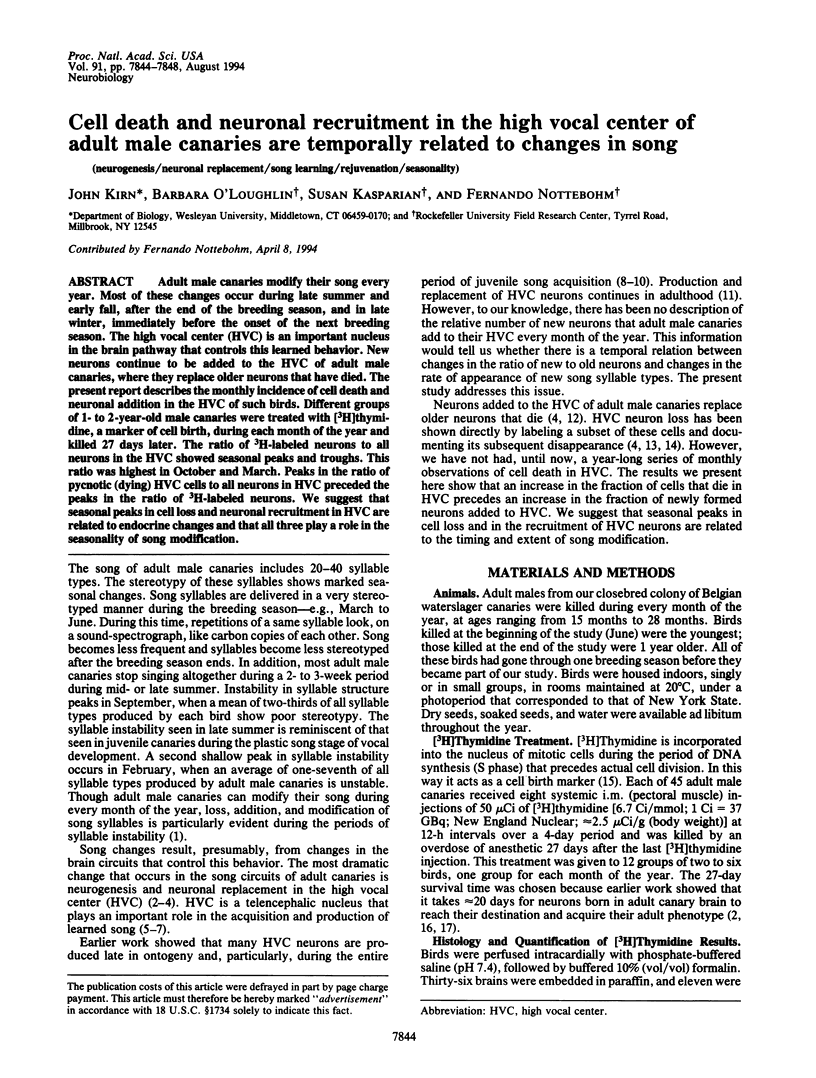
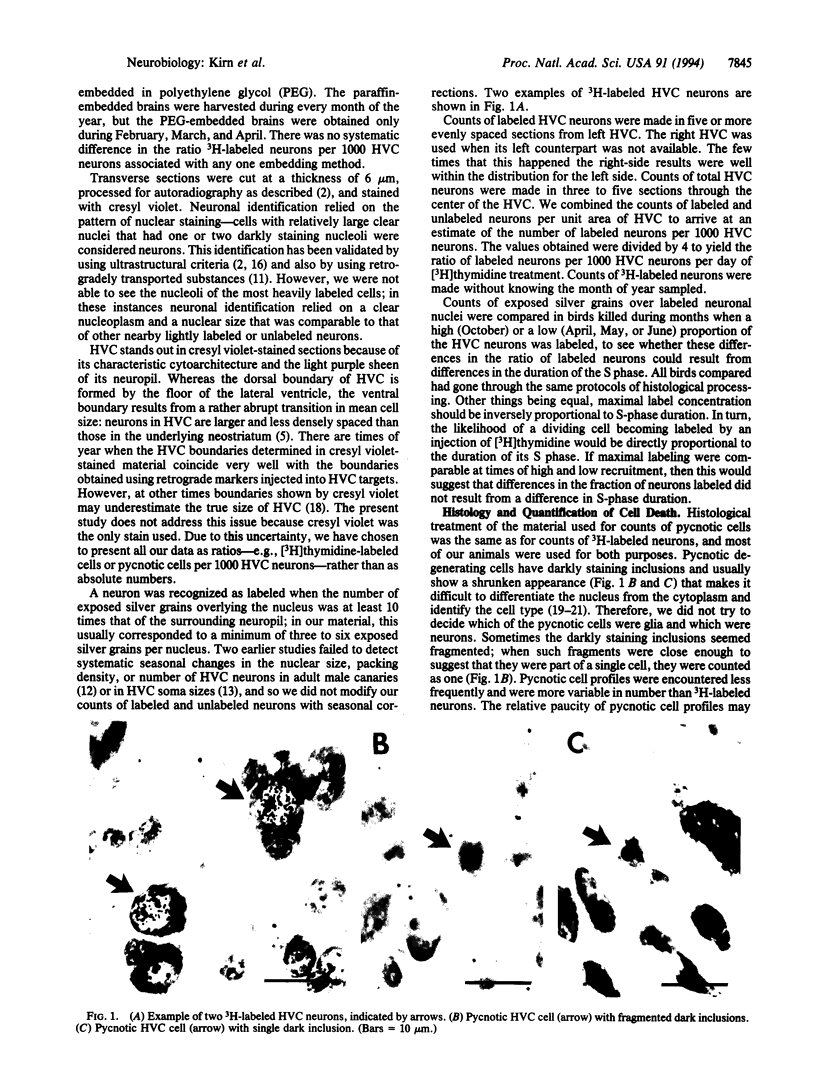
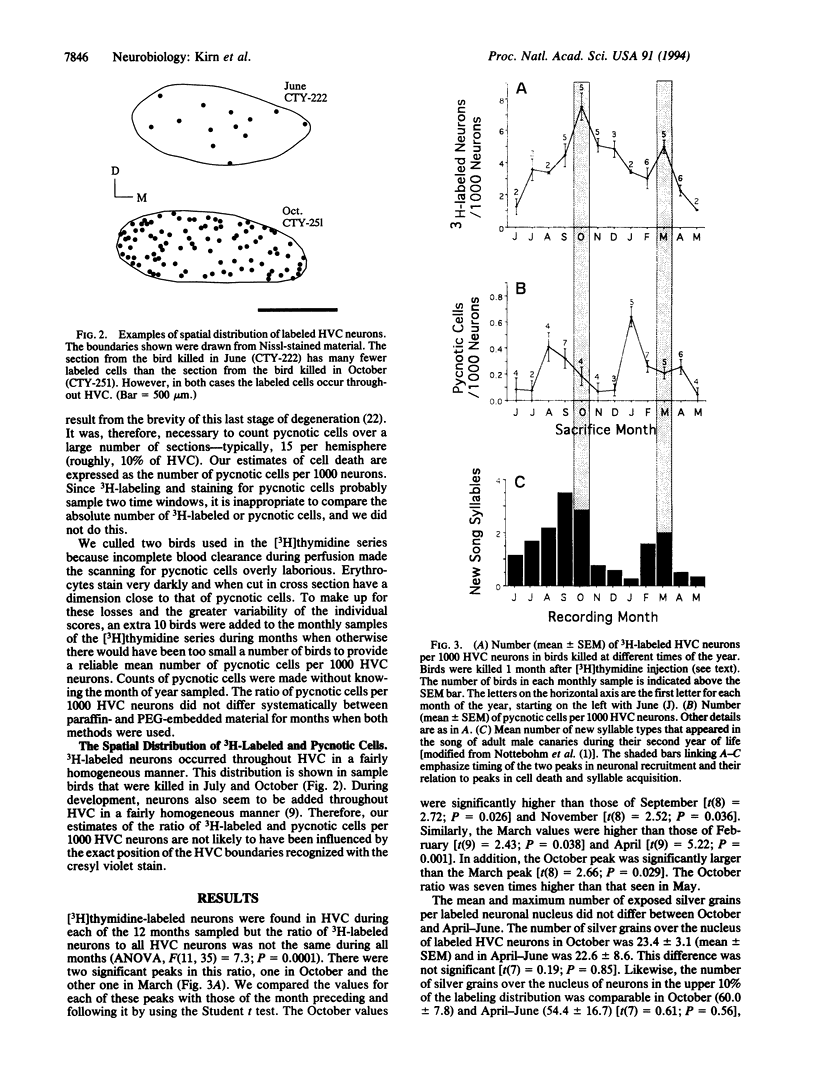
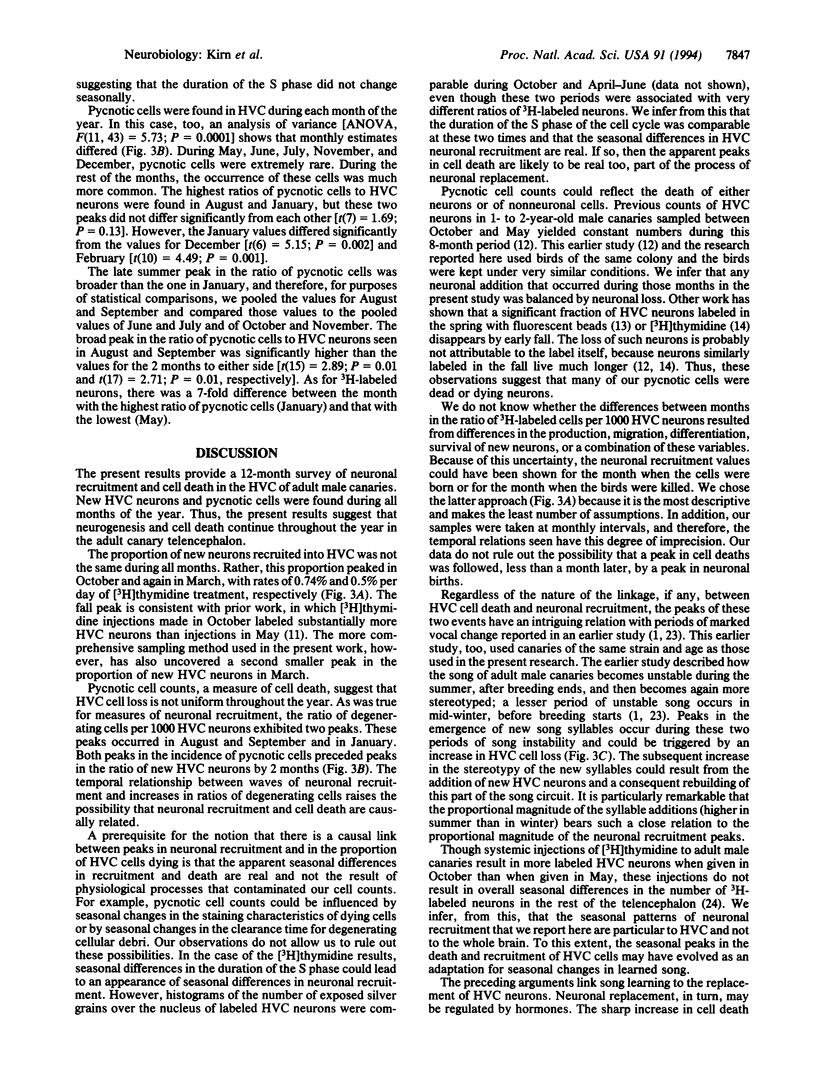
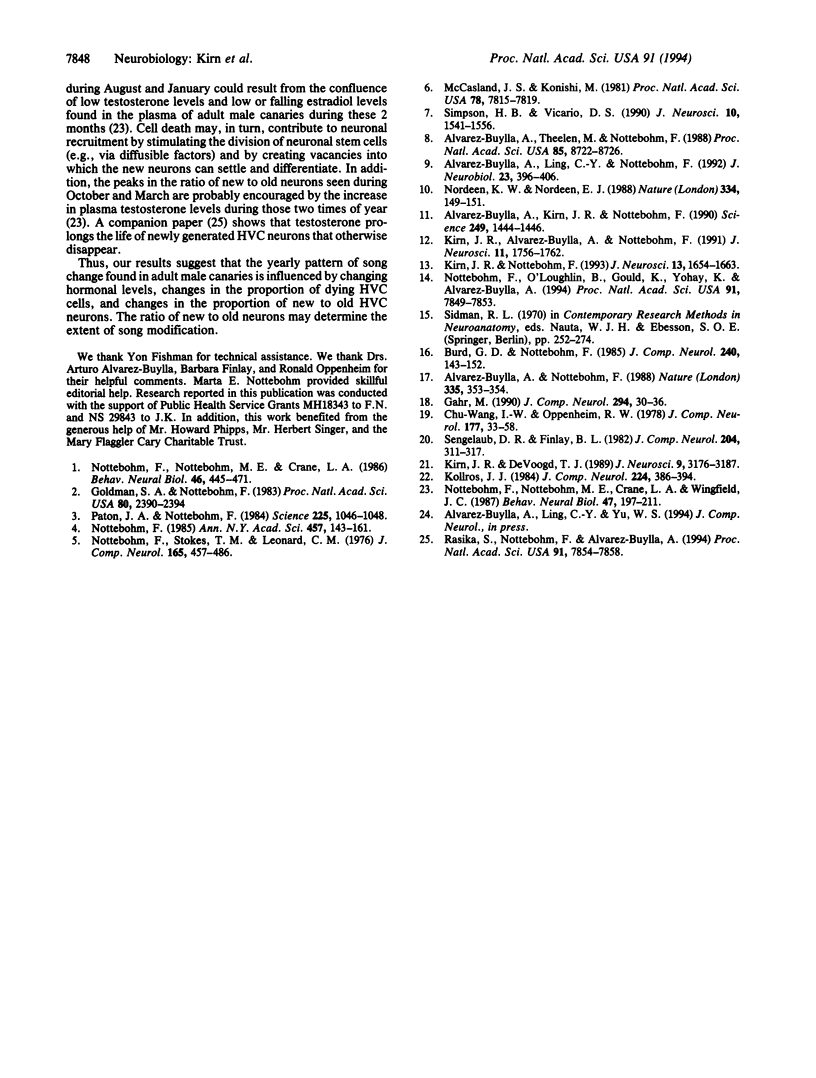
Images in this article
Selected References
These references are in PubMed. This may not be the complete list of references from this article.
- Alvarez-Buylla A., Kirn J. R., Nottebohm F. Birth of projection neurons in adult avian brain may be related to perceptual or motor learning. Science. 1990 Sep 21;249(4975):1444–1446. doi: 10.1126/science.1698312. [DOI] [PubMed] [Google Scholar]
- Alvarez-Buylla A., Ling C. Y., Nottebohm F. High vocal center growth and its relation to neurogenesis, neuronal replacement and song acquisition in juvenile canaries. J Neurobiol. 1992 Jun;23(4):396–406. doi: 10.1002/neu.480230406. [DOI] [PubMed] [Google Scholar]
- Alvarez-Buylla A., Nottebohm F. Migration of young neurons in adult avian brain. Nature. 1988 Sep 22;335(6188):353–354. doi: 10.1038/335353a0. [DOI] [PubMed] [Google Scholar]
- Alvarez-Buylla A., Theelen M., Nottebohm F. Birth of projection neurons in the higher vocal center of the canary forebrain before, during, and after song learning. Proc Natl Acad Sci U S A. 1988 Nov;85(22):8722–8726. doi: 10.1073/pnas.85.22.8722. [DOI] [PMC free article] [PubMed] [Google Scholar]
- Burd G. D., Nottebohm F. Ultrastructural characterization of synaptic terminals formed on newly generated neurons in a song control nucleus of the adult canary forebrain. J Comp Neurol. 1985 Oct 8;240(2):143–152. doi: 10.1002/cne.902400204. [DOI] [PubMed] [Google Scholar]
- Chu-Wang I. W., Oppenheim R. W. Cell death of motoneurons in the chick embryo spinal cord. I. A light and electron microscopic study of naturally occurring and induced cell loss during development. J Comp Neurol. 1978 Jan 1;177(1):33–57. doi: 10.1002/cne.901770105. [DOI] [PubMed] [Google Scholar]
- Gahr M. Delineation of a brain nucleus: comparisons of cytochemical, hodological, and cytoarchitectural views of the song control nucleus HVc of the adult canary. J Comp Neurol. 1990 Apr 1;294(1):30–36. doi: 10.1002/cne.902940104. [DOI] [PubMed] [Google Scholar]
- Goldman S. A., Nottebohm F. Neuronal production, migration, and differentiation in a vocal control nucleus of the adult female canary brain. Proc Natl Acad Sci U S A. 1983 Apr;80(8):2390–2394. doi: 10.1073/pnas.80.8.2390. [DOI] [PMC free article] [PubMed] [Google Scholar]
- Kirn J. R., Alvarez-Buylla A., Nottebohm F. Production and survival of projection neurons in a forebrain vocal center of adult male canaries. J Neurosci. 1991 Jun;11(6):1756–1762. doi: 10.1523/JNEUROSCI.11-06-01756.1991. [DOI] [PMC free article] [PubMed] [Google Scholar]
- Kirn J. R., DeVoogd T. J. Genesis and death of vocal control neurons during sexual differentiation in the zebra finch. J Neurosci. 1989 Sep;9(9):3176–3187. doi: 10.1523/JNEUROSCI.09-09-03176.1989. [DOI] [PMC free article] [PubMed] [Google Scholar]
- Kirn J. R., Nottebohm F. Direct evidence for loss and replacement of projection neurons in adult canary brain. J Neurosci. 1993 Apr;13(4):1654–1663. doi: 10.1523/JNEUROSCI.13-04-01654.1993. [DOI] [PMC free article] [PubMed] [Google Scholar]
- Kollros J. J. Growth and death of cells of the mesencephalic fifth nucleus in Rana pipiens larvae. J Comp Neurol. 1984 Apr 10;224(3):386–394. doi: 10.1002/cne.902240306. [DOI] [PubMed] [Google Scholar]
- McCasland J. S., Konishi M. Interaction between auditory and motor activities in an avian song control nucleus. Proc Natl Acad Sci U S A. 1981 Dec;78(12):7815–7819. doi: 10.1073/pnas.78.12.7815. [DOI] [PMC free article] [PubMed] [Google Scholar]
- Nordeen K. W., Nordeen E. J. Projection neurons within a vocal motor pathway are born during song learning in zebra finches. Nature. 1988 Jul 14;334(6178):149–151. doi: 10.1038/334149a0. [DOI] [PubMed] [Google Scholar]
- Nottebohm F. Neuronal replacement in adulthood. Ann N Y Acad Sci. 1985;457:143–161. doi: 10.1111/j.1749-6632.1985.tb20803.x. [DOI] [PubMed] [Google Scholar]
- Nottebohm F., Nottebohm M. E., Crane L. A., Wingfield J. C. Seasonal changes in gonadal hormone levels of adult male canaries and their relation to song. Behav Neural Biol. 1987 Mar;47(2):197–211. doi: 10.1016/s0163-1047(87)90327-x. [DOI] [PubMed] [Google Scholar]
- Nottebohm F., Nottebohm M. E., Crane L. Developmental and seasonal changes in canary song and their relation to changes in the anatomy of song-control nuclei. Behav Neural Biol. 1986 Nov;46(3):445–471. doi: 10.1016/s0163-1047(86)90485-1. [DOI] [PubMed] [Google Scholar]
- Nottebohm F., O'Loughlin B., Gould K., Yohay K., Alvarez-Buylla A. The life span of new neurons in a song control nucleus of the adult canary brain depends on time of year when these cells are born. Proc Natl Acad Sci U S A. 1994 Aug 16;91(17):7849–7853. doi: 10.1073/pnas.91.17.7849. [DOI] [PMC free article] [PubMed] [Google Scholar]
- Nottebohm F., Stokes T. M., Leonard C. M. Central control of song in the canary, Serinus canarius. J Comp Neurol. 1976 Feb 15;165(4):457–486. doi: 10.1002/cne.901650405. [DOI] [PubMed] [Google Scholar]
- Paton J. A., Nottebohm F. N. Neurons generated in the adult brain are recruited into functional circuits. Science. 1984 Sep 7;225(4666):1046–1048. doi: 10.1126/science.6474166. [DOI] [PubMed] [Google Scholar]
- Rasika S., Nottebohm F., Alvarez-Buylla A. Testosterone increases the recruitment and/or survival of new high vocal center neurons in adult female canaries. Proc Natl Acad Sci U S A. 1994 Aug 16;91(17):7854–7858. doi: 10.1073/pnas.91.17.7854. [DOI] [PMC free article] [PubMed] [Google Scholar]
- Sengelaub D. R., Finlay B. L. Cell death in the mammalian visual system during normal development : I. Retinal ganglion cells. J Comp Neurol. 1982 Feb 1;204(4):311–317. doi: 10.1002/cne.902040402. [DOI] [PubMed] [Google Scholar]
- Simpson H. B., Vicario D. S. Brain pathways for learned and unlearned vocalizations differ in zebra finches. J Neurosci. 1990 May;10(5):1541–1556. doi: 10.1523/JNEUROSCI.10-05-01541.1990. [DOI] [PMC free article] [PubMed] [Google Scholar]




